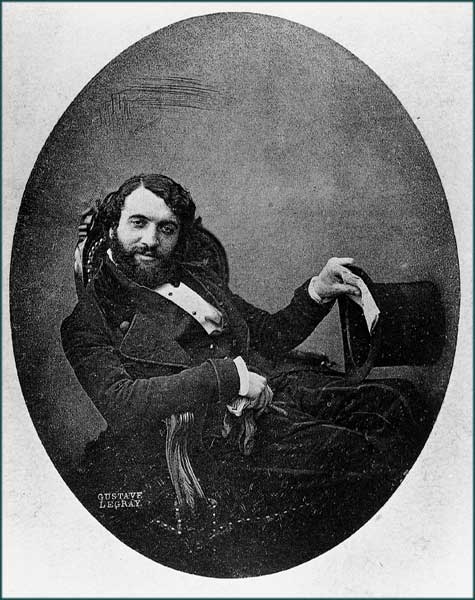- Henri Le Secq
Infobox Person
name = Henri Le Secq

image_size = 180px
caption = Portrait of Henri Le Secq byGustave Le Gray
birth_date = birth date|1818|8|18|df=y
birth_place =Paris
death_date = death date and age|1882|12|26|1818|8|18|df=y
death_place =Paris
occupation =Photographer
spouse =
parents =
children =Henri Jean-Louis Le Secq (
18 August 1818 –26 December 1882 ) was a French painter andphotographer . After the French government made thedaguerreotype open for public in 1851, Le Secq was one of the five photographers selected to carry out a photographic survey of architecture ("Commission des Monuments Historiques"). [cite web| url=http://www.rleggat.com/photohistory/history/le_secq.htm |title=History of photography by Robert Laggat|accessdate= 2007-03-22]Early life
Henri Le Secq was born in 1818 in Paris and was a son of a politician. He was trained in sculpture and worked in several studios. He was also a collector of wrought iron objects and the
Musée le Secq des Tournelles inRouen is devoted to him. [cite web| url=http://www.rouen-musees.com/tournelles/index.html| title=Musées de la ville de Rouen
accessdate=2007-03-22] He later started his photographic career underPaul Delaroche . [cite web |url=http://www.eastman.org/fm/amico99/htmlsrc1/intro.html |title=Biography at eastman.org|accessdate=2007-03-22]Middle years
He experimented with various photograph processing techniques together with his colleague
Charles Nègre and later worked withGustave Le Gray learning the waxed-paper negative process. This process had the advantage that it produced negatives unlike the daguerreotype process. He, along withHippolyte Bayard ,Edouard Baldus ,Gustave Le Gray andO Mestral , was sent on "Mission héliographique" to document famous architectural monuments in France. He worked mainly on cathedrals inChartres ,Strasbourg ,Reims and near Paris. Cameras capable of taking large photographs, size of 51 cm by 74 cm, were used. His works during this "Commission des Monuments Historiques" are considered to be his finest works. [cite web |url= http://www.luminous-lint.com/__sw.php?action=ACT_SING_PH&p1=Henri__Le_Secq&p2=ABCDEFGHIJKLN |title= Luminous-Lint| accessdate=2007-03-22] In 1851 he became one of the founders of the first photographic organization of the world, unfortunately very short lived,Société héliographique (1851 - 1853). [cite web| url = http://www.getty.edu/art/gettyguide/artMakerDetails?maker=1774&page=1| title=Getty Museum| accessdate=2007-03-22]Later years
He gave up photography after 1856 but continued to paint and collect art. Around 1870 he started reprinting his famous works as
cyanotype s as he was afraid of possible loss due to fading. He gave the reprints dates of the original negatives, some of which are still in good condition. [cite book|title=Cyanotype : The history, science and art of photographic printing in Prussian blue|first=Mike |last= Ware|isbn=1-900747-073]Notes
References
* Janis, Eugenia Parry, and Josianne Sartre. Henri Le Secq; "Photographe de 1850 a 1860. Catalogue Raisonné de la Collection de la Bibliotheque des Arts Decoratifs", Paris 1986 ISBN 2-08-012056-5
* Chartres & Prose Poems. With photographs by Henri Le Secq. NY: The Eakins Press, 1970
* Antic de Mondenard, "La Mission heliographique, Cinq photographes parcourent la France en 1851", published by Monum, editions du patrimoine, France, 2002
*External links
* [http://www.peib.org.uk/itemphotographer.php?photogNo=234&orderby=coverage&photogName=Le+Secq%2C+Henri+(1818-1882) Photographic exhibitions in Britain 1835 - 1865]
* [http://www.time.com/time/magazine/article/0,9171,843964,00.html?promoid=googlep Article in TIME]Persondata
NAME=Henri Le Secq
ALTERNATIVE NAMES=
SHORT DESCRIPTION=
DATE OF BIRTH=18 August 1818
PLACE OF BIRTH=Paris, France
DATE OF DEATH=26 December 1882
PLACE OF DEATH=Paris, France
Wikimedia Foundation. 2010.
